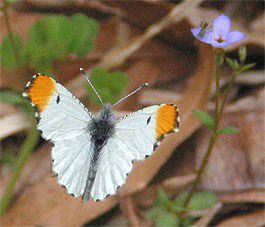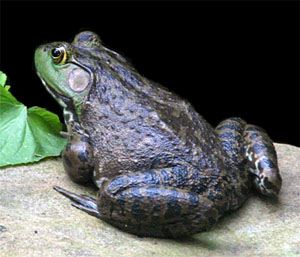NOT CRICKETS, BUT CRICKET FROGS
Since mid-February on reasonably warm evenings--i.e, temperatures 50 degrees or higher--we've been serenaded at Hilton Pond Center by the "peep . . . peep . . . peep" of Spring Peeper frogs. In fact, these testosterone-laden little amphibians were even cranked up and singing for a while back in mid-November, as we reported in a previous installment of "This Week." And now, for the past fortnight, the peeping peepers have been accompanied by another sound--a clicking noise like two marbles being knocked together with increasing tempo: "gick . . . gick . . gick . gick-gick-gick-gick-gick." The clicking isn't as melodic as the peeping but is just as loud--a sure sign that another tiny amphibian is feeling the mating urge. In this case, it's the Northern Cricket Frog, whose vocalization often misleads budding naturalists into thinking the local wetlands are full of calling insects.
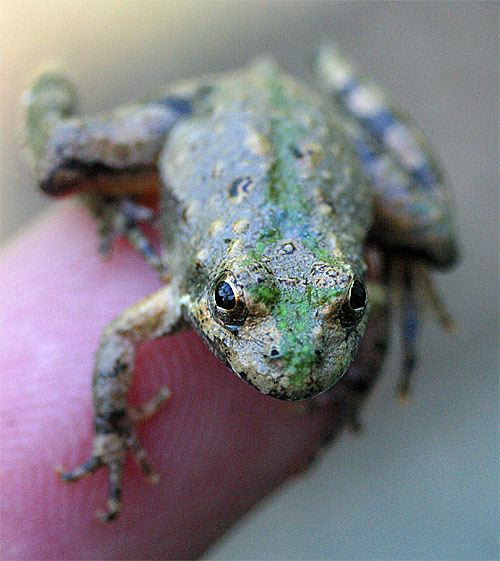
All text & photos © Hilton Pond Center
Just as the call of Acris c. crepitans--the Northern Cricket Frog--misleads some folks into thinking it's an insect, so is the rest of its name misleading; hardly limited to the North, it occurs from New York (where it's an endangered species) to the Gulf Coast states; a related subspecies, A. c. blanchardi, is found throughout the Midwest and even into southern Canada. There's also a SOUTHERN Cricket Frog, A. gryllus, which IS limited to the extreme southeastern U.S. In the Carolinas the Northern Cricket Frog is essentially a Piedmont species--colonies are found here and there in the mountain valleys--while its southern cousin is restricted to the Coastal Plain. By the way, the scientific name of the Northern Cricket Frog further reflects the similarity of its vocalization to that of an insect; Acris comes from a Greek word for the noisy midsummer locust, and crepitans is Latin for "clattering."
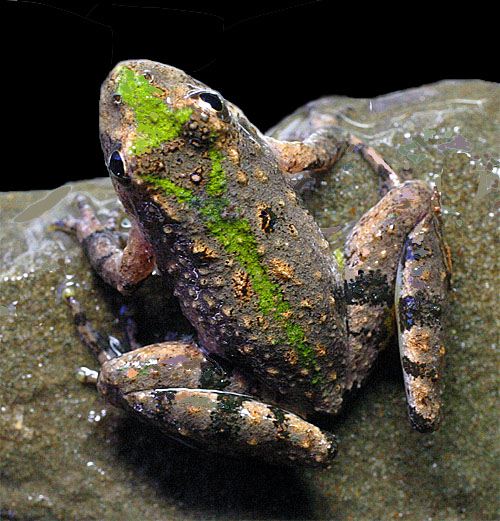
Only .5 to 1.5 inches long, the adult Northern Cricket Frog is our most diminutive Piedmont frog, being slightly smaller than the Spring Peeper. (The Little Grass Frog, Limnaoedus ocularis, is the Carolinas'--and North America's--smallest frog, but it, too, is a Low Country species that doesn't stray into the Piedmont.) Northern Cricket Frogs are highly camouflaged and, although diurnal, are seldom noticed unless you almost step on one and happen to see it leap away, zigzagging with each successive jump. We encountered the individual shown on this page below the Hilton Pond dam in a flat, moist area covered with leaf litter. As we crouched and leaned toward an interesting fungus growing on the ground, the previously unseen frog jumped about 12" and we were fortunate to grab it before a few more bounds took it to shelter in a nearby stream.
Northern Cricket Frogs are tree frogs that don't climb. They have rather rough, warty skin that stays moist enough so they can embark on terrestrial feeding forays some distance from standing water. 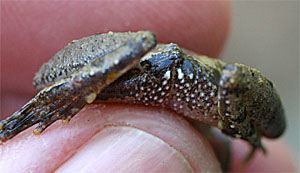 Their bodies are highly variable in color--green, yellow, a brownish hue, or even red-clay red--but they almost always have a dark triangle between their protruding eyes (see photo above); usually, a Y-shaped stripe of contrasting color extends from the triangular spot toward the rump. Together with very long legs and a somewhat pointed snout, these markings help separate the species from the similar-sized Spring Peeper with an "X" on its back, but the characteristics don't differentiate between Northern and Southern Cricket Frogs. To make that distinction, one simply looks at the frog's rump (above right), where two prominent white tubercles are a sure indication of the Northern Cricket Frog--which also has more webbing between its hind toes than do Southern Cricket Frogs. Their bodies are highly variable in color--green, yellow, a brownish hue, or even red-clay red--but they almost always have a dark triangle between their protruding eyes (see photo above); usually, a Y-shaped stripe of contrasting color extends from the triangular spot toward the rump. Together with very long legs and a somewhat pointed snout, these markings help separate the species from the similar-sized Spring Peeper with an "X" on its back, but the characteristics don't differentiate between Northern and Southern Cricket Frogs. To make that distinction, one simply looks at the frog's rump (above right), where two prominent white tubercles are a sure indication of the Northern Cricket Frog--which also has more webbing between its hind toes than do Southern Cricket Frogs.
A male Northern Cricket Frog in breeding condition has a dark chin (below left)--a gular sac that is distended and filled with air to help make the clicking call. 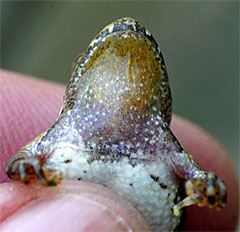 When a female selects a mate--supposedly based on the quality and volume of his call--the smaller male mounts and scatters his milt as she lays eggs, gambling that at least some sperm cells will carry out fertilization. Although not that large herself, the female lays up to 200 gelatinous eggs either individually or in clusters of 3-15 on submerged vegetation; sometimes eggs are merely released on the pond bottom. Her tadpoles, whose tail tips are noticeably black, hatch in 3-4 days but take a relatively long time to metamorphose, not emerging as adults until August or September. Thanks mostly to predatory snakes, fish, birds, and larger frogs, most Northern Cricket Frogs live perhaps six months in the wild, but captive individuals have been reported to be reproductively active for up to TEN years--an amazing life span for such a tiny creature. For this and other reasons, we were careful after this week's photography session to return our frog to the exact spot where we captured it. When a female selects a mate--supposedly based on the quality and volume of his call--the smaller male mounts and scatters his milt as she lays eggs, gambling that at least some sperm cells will carry out fertilization. Although not that large herself, the female lays up to 200 gelatinous eggs either individually or in clusters of 3-15 on submerged vegetation; sometimes eggs are merely released on the pond bottom. Her tadpoles, whose tail tips are noticeably black, hatch in 3-4 days but take a relatively long time to metamorphose, not emerging as adults until August or September. Thanks mostly to predatory snakes, fish, birds, and larger frogs, most Northern Cricket Frogs live perhaps six months in the wild, but captive individuals have been reported to be reproductively active for up to TEN years--an amazing life span for such a tiny creature. For this and other reasons, we were careful after this week's photography session to return our frog to the exact spot where we captured it.
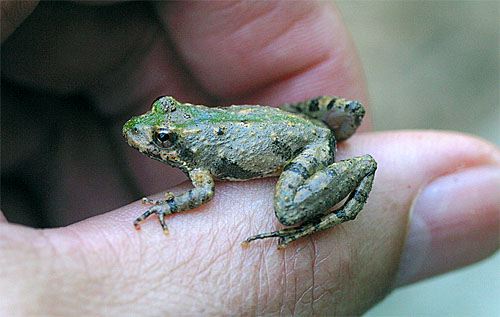
Northern Cricket Frog tadpoles are fully gilled and completely aquatic; they primarily eat algae but change over to insects, worms, and small crustaceans when they gain legs and lungs and lose their tails. Both larval and adult Northern Cricket Frogs are sensitive to habitat contamination from run-off and other pollutants, while hundreds or thousands of the species' historic breeding areas in the Carolina Piedmont and elsewhere have been drained and lost forever to development. As a result, this species--once the most common frog in many parts of the eastern and central U.S.--now occurs in greatly reduced numbers across much of its range. Here at Hilton Pond Center we try to do our part to assure that current and future generations of Northern Cricket Frogs have uncontaminated water in which to breed, and wetlands where they can forage. For us, a spring without the insect-like clicking sounds of cricket frogs would be unthinkable.
All text & photos © Hilton Pond Center
Comments or questions about this week's installment?
Please send an E-mail message to INFO.
NOTE: Be sure to scroll down for an account of all birds banded or recaptured during the week, as well as some other interesting nature notes.
"This Week at Hilton Pond" is written & photographed
by Bill Hilton Jr., executive director of
Hilton Pond Center for Piedmont Natural History.
You may wish to consult our Index of all nature topics covered since February 2000. You can also use the on-line Search Engine at the bottom of this page.
For a free, non-fattening, on-line subscription to "This Week at Hilton Pond," just send us an E-mail with SUBSCRIBE in the Subject line. Please be sure to configure your spam filter to accept E-mails from hiltonpond.org.
|



 Their bodies are highly variable in color--green, yellow, a brownish hue, or even red-clay red--but they almost always have a dark triangle between their protruding eyes (see photo above); usually, a Y-shaped stripe of contrasting color extends from the triangular spot toward the rump. Together with very long legs and a somewhat pointed snout, these markings help separate the species from the similar-sized Spring Peeper with an "X" on its back, but the characteristics don't differentiate between Northern and Southern Cricket Frogs. To make that distinction, one simply looks at the frog's rump (above right), where two prominent white tubercles are a sure indication of the Northern Cricket Frog--which also has more webbing between its hind toes than do Southern Cricket Frogs.
Their bodies are highly variable in color--green, yellow, a brownish hue, or even red-clay red--but they almost always have a dark triangle between their protruding eyes (see photo above); usually, a Y-shaped stripe of contrasting color extends from the triangular spot toward the rump. Together with very long legs and a somewhat pointed snout, these markings help separate the species from the similar-sized Spring Peeper with an "X" on its back, but the characteristics don't differentiate between Northern and Southern Cricket Frogs. To make that distinction, one simply looks at the frog's rump (above right), where two prominent white tubercles are a sure indication of the Northern Cricket Frog--which also has more webbing between its hind toes than do Southern Cricket Frogs. When a female selects a mate--supposedly based on the quality and volume of his call--the smaller male mounts and scatters his milt as she lays eggs, gambling that at least some sperm cells will carry out fertilization. Although not that large herself, the female lays up to 200 gelatinous eggs either individually or in clusters of 3-15 on submerged vegetation; sometimes eggs are merely released on the pond bottom. Her tadpoles, whose tail tips are noticeably black, hatch in 3-4 days but take a relatively long time to metamorphose, not emerging as adults until August or September. Thanks mostly to predatory snakes, fish, birds, and larger frogs, most Northern Cricket Frogs live perhaps six months in the wild, but captive individuals have been reported to be reproductively active for up to TEN years--an amazing life span for such a tiny creature. For this and other reasons, we were careful after this week's photography session to return our frog to the exact spot where we captured it.
When a female selects a mate--supposedly based on the quality and volume of his call--the smaller male mounts and scatters his milt as she lays eggs, gambling that at least some sperm cells will carry out fertilization. Although not that large herself, the female lays up to 200 gelatinous eggs either individually or in clusters of 3-15 on submerged vegetation; sometimes eggs are merely released on the pond bottom. Her tadpoles, whose tail tips are noticeably black, hatch in 3-4 days but take a relatively long time to metamorphose, not emerging as adults until August or September. Thanks mostly to predatory snakes, fish, birds, and larger frogs, most Northern Cricket Frogs live perhaps six months in the wild, but captive individuals have been reported to be reproductively active for up to TEN years--an amazing life span for such a tiny creature. For this and other reasons, we were careful after this week's photography session to return our frog to the exact spot where we captured it.


